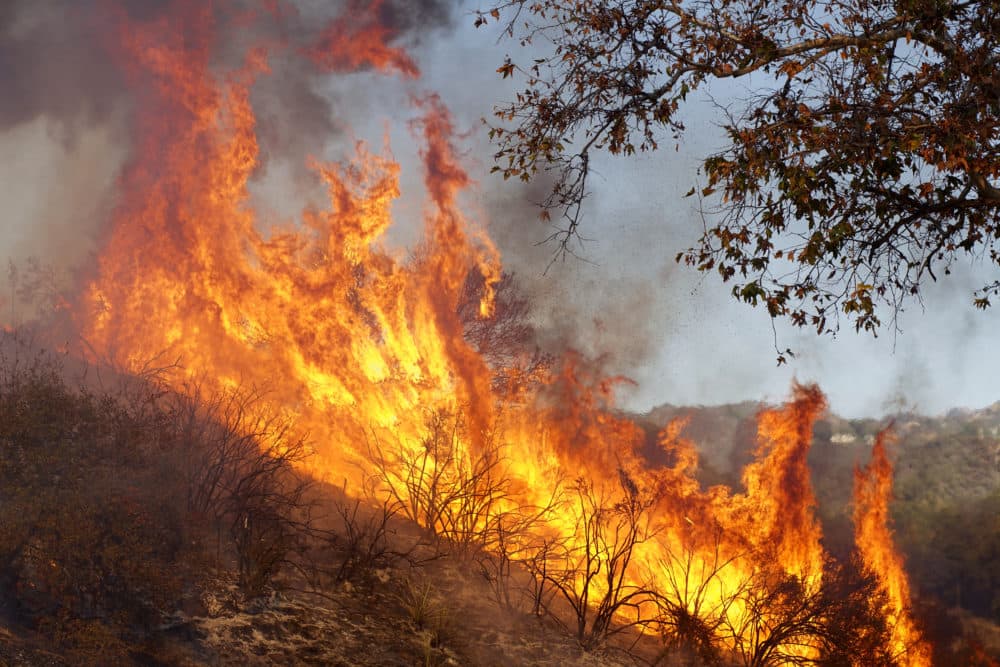Wildfires

Climate change has inexorably stacked the deck in favor of bigger and more intense fires across the American West over the past few decades, science has incontrovertibly shown. Increasing heat, changing rain and snow patterns, shifts in plant communities, and other climate-related changes have vastly increased the likelihood that fires will start more often and burn more intensely and widely than they have in the past.
The scale and intensity of the wildfires burning across the western U.S. right now is “staggering,” says Philip Higuera, a wildfire scientist and paleoecologist at the University of Montana. More than five million acres have already burned this year—and much more may be yet to come.
Higher temperatures and drought increase the potential for wildfire.
Climate change exacerbates the factors that create perfect fire conditions. Lower precipitation and warmer air temperatures dry the forests and other vegetation. Add strong winds and decades of fire suppression into the mix and you have a dangerous recipe for wildfire.
Noah Diffenbaugh, a climate scientist at Stanford University, makes a baseball analogy to describe increase in risk. “If there’s a three-run home run in baseball, it’s the home run that definitely caused the runners to round the bases and score. The home run is the proximal cause of the event. But people being on base matters," he says, and global warming is putting people on base.
Other factors also hike fire risk, like forest management decisions that have allowed for the buildup of vast amounts of vegetation that can quickly turn into fuel, as well as more problematic issues like the slow creep of houses and other infrastructure into risky areas. But for fires near that so-called wildland-urban interface, as well as more remote, forest-centered burns, climate change has significantly heightened the baseline risks.
Heat like a thirsty sponge
In some ways, fire is simple. It takes three components: the right weather and climate conditions, plenty of burnable fuel, and a spark.
Climate change has affected the first two components (and in some cases, the third) in clear, measurable ways that have become increasingly obvious over the past few decades.
The clearest connection is with warming air temperatures. The planet has heated up nearly continuously since the start of the Industrial Revolution in the late 1800s, when humans started burning massive quantities of fossil fuels, releasing carbon dioxide that traps excess heat in the atmosphere. Since then, global average temperatures have ticked up roughly 1.8 degrees Fahrenheit (1 degree Celsius); California’s change is closer to 3 degrees Fahrenheit. Warming has accelerated since the 1980s to just under 0.2 degrees Celsius (0.3 degrees F) per decade, and it's likely to accelerate further in the future.
That might not seem like very much warming, but just a little can go a long way. Hot air, if it’s not at 100 percent humidity, is like a thirsty sponge: It soaks up water from whatever it touches—plants (living or dead) and soil, lakes and rivers. The hotter and drier the air, the more it sucks up, and the amount of water it can hold increases exponentially as the temperature rises; small increases in the air's heat can mean big increases in the intensity with which it pulls out water. Scientists can measure this "vapor pressure deficit"—the difference between how much water the air holds and how much it could hold. If that deficit is cranked up for a long time, soils and vegetation will parch.
CLIMATE 101: WILDFIRES
What are wildfires and how do they start? Learn how we can prevent destructive wildfires, and how we can manage wildfires to improve the health of forests. Select Footage Courtesy NASA: https://svs.gsfc.nasa.gov/11997 https://www.nasa.gov/topics/earth/features/wildfires.html https://svs.gsfc.nasa.gov/12742
A brief heat spell will dry out the smallish stuff or the already dead stuff—and maybe even some of the bigger tinder. Intense, record-breaking heat waves like the ones that encompassed the West during August and early September likely caused major crisping of burnable material, as the regional vapor pressure deficit and associated drought climbed to record levels.
“In a lot of places, you have a lot of ‘flashy’ fuel on the ground,” says Balch. “This stuff that’s as thin as paper—(like) grasses. Short-term drought events or heat waves are really impactful for drying those out.” That small stuff ignites so easily that it can often help speed along a fire’s spread.
When excess heat stays in place for months or longer, the wildfire risk rises even further.
An early, warm spring can jump-start a summer drought by extending the season of heat and growth, increasing the amount of water vapor that is shed by plant leaves or that evaporates directly from soil. Lower soil moisture, in turn, can feed back into the local warming cycle and intensify it, since evaporating moisture usually takes up a lot of the energy the sun beams down. When there’s no moisture left to evaporate, the soil or vegetation, dead and alive, absorbs that heat instead—feeding back into the drying-out process that increases fire risk.
Climate change intensifies wildfires in the West.
Fire radiative power (FRP) is the rate of radiant heat emitted by a fire. California and Oregon’s 2020 fire season has the highest fire intensity of the ...
Click here to read the rest of the text.